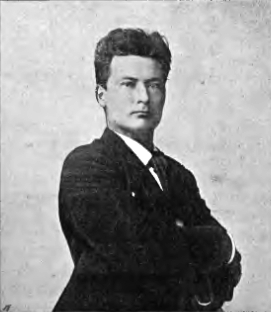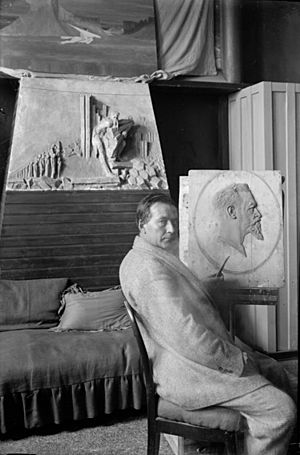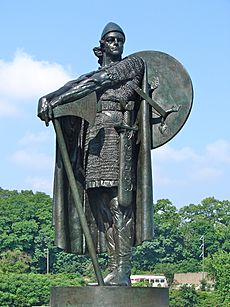Einar Jónsson facts for kids
Quick facts for kids
Einar Jónsson
|
|
|---|---|

Einar Jónsson in 1906
|
|
| Born |
Einar Jónsson
11 May 1874 Galtafell, Iceland
|
| Died | 18 October 1954 (aged 80) |
| Nationality | Icelandic |
| Signature | |
 |
|
Einar Jónsson (born May 11, 1874 – died October 18, 1954) was a famous Icelandic sculptor. He was born on a farm called Galtafell in southern Iceland. Einar became known for his unique and symbolic artworks. He created many important statues that you can see in Iceland and other countries.
Contents
Einar Jónsson's Life and Art
Early Life and Studies
Einar Jónsson showed artistic talent from a young age. At that time, there wasn't much sculpture in Iceland. So, Einar moved to Denmark to study art. He attended the Copenhagen Academy of Art.
In 1902, the Althing, which is Iceland's parliament, gave Einar money to study in Rome for two years. After Rome, he returned to Copenhagen and lived there. The Einar Jónsson Museum in Reykjavik says that after his time in Rome, Einar changed his artistic ideas.
Developing a Unique Style
Einar decided not to create art that looked exactly like real life. He felt that older art styles held artists back. He believed artists should find their own way. They should use their imagination and create original works. His ideas were similar to a style called German symbolism. He developed a way of using symbols and ideas to tell stories in his sculptures.
In 1909, Einar had lived outside Iceland for almost 20 years. He made an agreement with the Althing. They would give him a home and a studio in Reykjavík. In return, he promised to give all his artworks to Iceland. Einar designed his home and studio with architect Einar Erlendsson.
Famous Sculptures Abroad
In 1914, Einar received an important job. A man named Joseph Bunford Samuel asked him to create a statue of the Icelandic explorer Þorfinnur Karlsefni. This statue was meant for Philadelphia in the United States. It was part of a series of sculptures about American history.
The statue, called Thorfinn Karlsefni, was finished between 1915 and 1918. It was placed in Philadelphia and unveiled in 1920. You can also find another copy of this statue in Reykjavík, Iceland.
In 1917, Einar traveled to the United States to finish his work. A few years later, in 1921, another one of his major works was placed in North America. The Icelandic community in Manitoba, Canada, bought a copy of his Jón Sigurðsson statue. They placed it on the grounds of the Manitoba Legislative Building in Winnipeg. This statue, like the one in Reykjavík, includes a bas relief (a type of carving that sticks out from a flat surface) called The Pioneers on its base.
Working in Iceland
After two years in America, Einar returned to Iceland. He created many amazing artworks there. Unlike most sculptors, Einar mostly worked with plaster. This was partly because there wasn't much good modeling clay in Iceland. Working with plaster allowed him to spend many years on a single sculpture. It wasn't unusual for him to work on a piece for over ten years.
Einar's Sculpture Style and Themes

Einar's sculptures can be grouped into three main types. First, there were the public statues he was asked to make for the government. Second, he created private works like portraits and cemetery monuments. The third group was his personal artworks. These pieces often showed his deep spiritual beliefs and his connection to Icelandic stories.
Einar's art often features characters from Icelandic Mythology and folk tales. You might see Elfs, "Hidden people" (also called "Huldufolk"), Vættir (nature spirits), Jötnar (giants), angels, and trolls. He also sculpted beautiful women and brave warriors. His works always have a deeper meaning, even if it's not always easy to understand.
Henry Goddard Leach, a writer, described Einar Jónsson's art this way:
- All things considered, Jonsson is unique in the world of art.
- If he had any prototype they were the symbolic artists of ancient
- Egypt. But Jonsson's nearest spiritual relative is William Blake.
In recent years, many of Einar's plaster sculptures have been cast in bronze. These bronze copies are now placed in the garden of his home and studio, and in city parks across Reykjavík and Iceland.
Einar donated all his artworks to the Einar Jónsson Museum in Reykjavík. The museum opened in 1923 and allows everyone to see his incredible creations.
Public Monuments
- The Outlaw – 1900
- Jónas Hallgrímsson – 1907
- Jón Sigurðsson – 1911
- Christian IX – 1915
- Þorfinnur Karlsefni – 1920
- Hallgrímur Pétursson – 1922
- Ingólfur Arnarson – 1924
- Hannes Hafstein – 1931
Private Commissions
- Memorial to the Eisert Family of Lodz, Poland 1935
- Monument to Dr. Charcot and His Ship – 1936
- Memorial to a Lost Airliner - 1952
- Various cemetery markers, including ones for Hannes Hafstein and his wife Ragnheiður
Other Works
- Birth of Psyche – 1915–18
- Breaking the Spell I – 1916–22
- Breaking the Spell II – 1916–27
- Dawn – 1897–1906
- End – 1906–38
- Evolution – 1913–14
- Fantasy on Yggdrasill, the Tree of Life – 1949
- Fate – 1900–27
- Grief – 1926–27
- Guilty Conscience – 1911–47
- King of Atlantis – 1919–22
- Pioneer – 1902–11
- Sparks I – 1913–31
- Spirit and Matter – 1918–22
- Thor Wrestling with Old Age – 1939–40
- Trees of Life and Death – 1909–40


